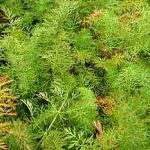| Common Name: |
Zira |
| Other Names: |
Comino, Cumin, Cummin Jeera, Jeeraka |
| Botanical Name: |
Cuminum cymimum |
| Genus: |
Cuminum |
| Family: |
Apiaceae |
| Native Location: |
E. Mediterranean, United States, Egypt, India, Morocco, Russia |
| Cultivation: |
Well-drained, fertile soil in full sun. Seeds may not ripen in cold climates. |
| Propagation: |
By seed sown in spring at 13-18°C (55-64°F) |
| Harvest: |
Seeds are collected when ripe and stored whole. They are used whole or ground for culinary use, or distilled for oil. |
| Height: |
30cm (12in) |
| Width: |
30cm (12in) |
| Hardiness: |
Half hardy |
| Extraction: |
Steam Distillation |
| Parts Used: |
Seeds, oil, Fruit |
| Color and Odor: |
The essential oil is yellow in color and has a spicy, penetrating and extremely pungent odor. |
| Background: |
Use by the Egyptians and the Hebrews since antiquity. It was also highly esteemed by the Greeks and Romans. Introduced to Britain during the Middle Ages. A traditional spice in the Middle East, cumin is nowadays used as an ingredient for Indian curries. |
| Properties: |
Digestive, stimulant, tonic, carminative, antispasmodic, aperitif, emmenagogic, aphrodisiac.
An aromatic, astringent herb that benefits the digestive system and acts as a stimulant to the sexual organs. The oil is anti-bacterial and larvacidal. |
| Precautions: |
This oil is best used in lower concentrations as it may cause irritation in sensitive people. The overpowering and lingering odor may also be too strong for some people. |
| Planet: |
Mars |
| Element: |
Fire |
| Magical Influences: |
Protection. |
| Medicinal Uses: |
Internally for minor digestive problems and migraine of digestive origin. Externally, ground with onion juice for poisonous stings. Widely used in Ayurvedic medicine to promote the assimilation of other herbs and to improve liver function: also used in veterinary medicine.
To treat diarrhea, colic, leprosy, and kidney and bladder stones; to induce abortions. |
| Typical Dose: |
A typical dose of cumin may range from 300 to 600 mg of the herb. |
| Possible Side Effects: |
No side effects are known when cumin is taken in recommended therapeutic dosages. |
| Drug Interactions: |
| Taking cumin with these drugs may increase the risk of hypogylcemia (low blood sugar): |
| Acarbose, (Prandase, Precose) |
Acetohexamide, (Acetohexamide) |
Chloropropamide, (Diabinese, Novo-Propamide) |
Gliclazide, (Diamicron, Novo-Gliclazide) |
| Glimepiride, (Amaryl) |
Glipizide, (Glucotrol) |
Glipizide and Metformin, (Metaglip) |
Gliquidone, (Beglynor, Glurenorm) |
| Glyburide, (DiaBeta, Micronase) |
Glyburide and Metformin, (Glucovance) |
Insulin, (Humulin, Novolin R) |
Metformin, (Glucophage, Riomet) |
| Miglitol, (Glyset) |
Nateglinide, (Starlix) |
Pioglitazone, (Actos) |
Repaglinide, (GlucoNorm, Prandin) |
| Rosiglitazone, (Avandia) |
Rosiglitazone and Metformin, (Avandamet) |
Tolazamide, (Tolinase) |
Tolbutamide, (Apo-Tolbutamide, Tol-Tab) |
|
| Disease Effects: |
May interfere with blood sugar control in diabetes. |
| Culinary Uses: |
Seeds are used to flavor soups, sauces, pickles, chutneys, and bread; important in spice mixtures such as garam masala (India), and in couscous and falafel (Middle East), and give a characteristic flavor to to Eastern dishes based on lamb, and to side-dishes of cucumber and yogurt. |
| Economic Uses: |
Oil is used commercially to flavor sauces and sausages. |
| Uses: |
- Digestive Sytem—Cumin is helpful for sluggish digestion. It relieves griping pains, dyspepsia, flatulence, bloating or diarrhoea.
- Circulatory System—General tonic and stimulant action on the heart which helps to regulate the metabolic process and is a good remedy for a weak heart and slow circulation.
- Reproductive Sytem—Aphrodisiac action promotes fertility and libido in both men and women. Regulates menstrual cycle.
- Muscular System—Warming effect helpful for muscular pains.
- Skeletal System—Beneficial for joint pains.
- Emotions—Cumin's strong tonic action on the nervous system helps with tiredness and lethargy. It is powerfully stimulating and penetrates the senses, having an evocative and erotic effect. The odor of cumin induces a sense of protection against negative feelings in oneself and one's environment. Given its unique aroma, it makes a somewhat bizarre, though effective, aphrodisiac.
|
| Blends: |
| DIGESTIVE |
CIRCULATORY |
REPRODUCTIVE |
| Cumin 4 |
Cumin 4 |
Cumin 4 |
| Orange 4 |
Rosemary 4 |
Neroli 4 |
| Ginger 4 |
Melissa 2 |
Geranium 2 |
|
| MUSCULAR |
SKELETAL |
EMOTION |
| Cumin 4 |
Cumin 4 |
Cumin 4 |
| Coriander 4 |
Celery 4 |
Mandarin 4 |
| Lavender 4 |
Eucalyptus 4 |
Ylang-Ylang 4 |
| Bibliography: |
Aromatherapy Blends and recipes by Franzesca Watson Copyright © 1995 Thorsons, Harper Parker Publishing Inc. Pp 96-97
Magical Aromatherapy by Scott Cunningham Copyright © 1989 Llewellyn Publications, Inc. Pp 80-81
The Encyclopedia of Herbs by Deni Brown Copyright © 1995, 2001. pg. 186.
The Essential Herb-Drug-Vitamin Interaction Guide by Geo. T. Grossberg,MD and Barry Fox,PhD Copyright©2007 Barry Fox,PhD. Pp. 176-177 |
|

